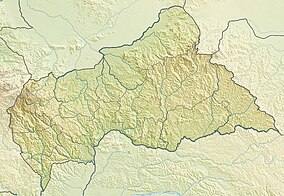Dzanga Ndoki National Park
| Dzanga-Ndoki National Park | |
|---|---|
|
IUCN category II (national park)
|
|
|
Location in Central African Republic
|
|
| Location |
|
| Nearest city | Berberati |
| Coordinates | 2°30′N 16°10′E / 2.500°N 16.167°ECoordinates: 2°30′N 16°10′E / 2.500°N 16.167°E |
| Area | 1,143.26 km2 (441.42 sq mi) |
| Established | 1990 |
The Dzanga-Ndoki National Park is located in the south-west of the Central African Republic. Established in 1990, the national park is 1,143.26 square kilometres (441.42 sq mi). The national park is split into two non-continuous sectors, the northern Dzanga sector (or Dzanga Park) 49,500 ha (122,000 acres) and the southern Ndoki sector (or Ndoki Park) 72,500 ha (179,000 acres). Notable in the Dzanga sector is a gorilla density of 1.6/km2 (4.1/sq mi), one of the highest densities ever reported for the western lowland gorilla.
Between the two sectors of the national park stretches the Dzanga-Sangha Special Reserve 335,900 ha (830,000 acres). The national park and the special reserve, each with its own protective status, are a part of the Dzanga-Sangha Complex of Protected Areas (DSPAC).
The Dzanga-Sangha National Park is located in the extreme southwest of the Central African Republic in a triangular-shaped part of the country. The main river running through this region is the Sangha River. The precise border between the Central African Republic, Cameroon and the Republic of the Congo is located at 2°13′14″N 16°11′31″E / 2.22056°N 16.19194°E (in the Sangha River), marking the furthest point of the park to the southwest.
The park's altitude ranges from 340 to 615 m (1,115 to 2,018 ft) above sea level. The whole park is on alluvial sands. Along streams, forest clearings can be found with marshy depressions referred to as 'bai'. The Dzanga Bai (translation: "the village of elephants") is a sandy salt lick that measures 250 by 500 m (820 by 1,640 ft). It is traversed through the middle by the Dzanga, a stream. Since 1997, Bai Hokou has the base site of the Primate Habituation Programme where gorilla habituation for tourism has been ongoing, along with research.
...
Wikipedia

